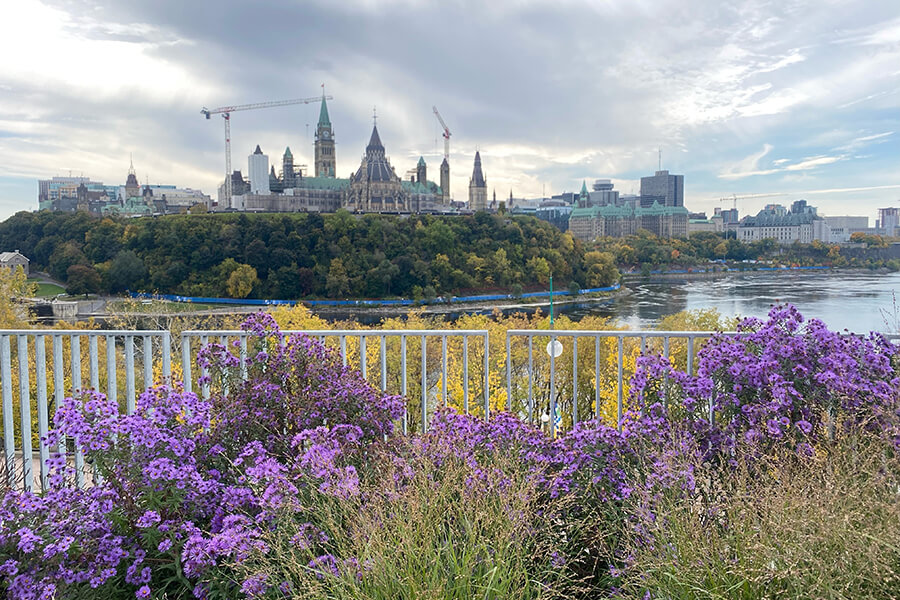Planting Design, Biodiversity, and our Changing Climate
Posted December 13, 2023

by Robert Beaudin, OALA
JRS Senior Landscape Architect and Horticulturist
The work of landscape architects has become increasingly essential in recent years. While we still believe that clever design solves many challenges for our clients, it is planting design that is increasingly on the front line of efforts to address biodiversity and the changing climate.
With the total global urban area expected to triple between the years 2000 and 2030 (Cities and Biodiversity Outlook, 2012), planting design for urban spaces offers an immense opportunity to enhance biodiversity and act as a tool for climate change mitigation and adaptation. As author Nigel Dunnet, Ambassador for the Royal Horticultural Society contends, “this means that places will look different, be used differently, be used by different people, and be looked after differently compared to how we do things now. It’s a radical ecological approach, a restorative ecology, repairing damaged places, bringing together human community and rich biodiversity”.
Nature vs. the City
Historically, nature and cities have not co-existed well. We have tended to view nature as something we travel outside of cities to experience and admire, not something that we live amongst. Cities do contain remnants of natural systems – some protected, some remaining through luck or difficult access – but these are often isolated pockets, lacking connection to broader systems and corridors. As cities continue to expand, there is a need to embrace nature within, removing the separation between the natural world and our constructed world. We must now encourage nature within cities by establishing biodiverse spaces, restoring degraded lands, and finding all opportunities to integrate nature into the built environment.
Planting design is evolving to include a greater variety of species to support greater biodiversity. Layered planting has replaced monoculture or block planting as it can perform various functions, including supporting biodiversity, sequestering carbon, and mitigating climate change. These goals are partly achieved by planting a larger variety of plants, including native plants and a larger variety of plant forms and rooting depths.
Preserving Existing Greenspaces
In addition to changing how we plant, we must also consider how existing greenspaces can be preserved, or enhanced. In some cases, a site offers more ecological and climate benefits by leaving existing soils and native vegetation intact. This simple action conserves existing flora, fauna, and sequestered carbon while also limiting carbon expenditure to re-build after site clearance. Every new tree planted carries an initial carbon footprint, while an existing greenspace conserves sequestered carbon, provides seed sources for natural regeneration, and retains existing habitat. The preserved lands benefit from physical connections to a wider landscape, so we consider opportunities to connect to other green spaces, extending natural corridors, and allowing natural migration.
Kìwekì Point Park
This new approach to diversity is exemplified by our work at Kìwekì Point Park in Ottawa, perched on a rocky outcrop above the Ottawa River, behind the National Gallery. 1,300 square metres of herbaceous planting was completed this past season with nearly 9,000 individual plants, extending the existing habitat of the river edge cliffs. Other areas of the park include grass, mown only where necessary, and 148 deciduous and coniferous trees. The park serves to broaden the abutting natural areas while blending them with the existing urban space, an example of one of many steps needed to allow nature to co-exist with the urban realm.
In the battle against climate change, planting design is becoming a significant tool landscape architects can employ to enhance biodiversity in an increasingly urban world. As author and conservationist Isabella Tree states in The Book of Wilding, “suddenly our isolated pockets of nature become part of a pulsing, functioning whole, a web of life that could revive our entire landscape, and so revise us.”
To read more:
- Wilding by Isabella Tree, Pan MacMillan, 2019
- The Book of Wilding, by Isabella Tree & Charlie Burrell, Bloomsbury Publishing, 2023
- BiodiverCities by 2030: Transforming Cities’ Relationship with Nature, World Economic Forum
- Landscape Design for Carbon Sequestration, by Deanna Lynn, 2020 ASLA Student Awards
- Designing Abundance with Claudia West, Wonderground
- Resilient Design: Biodiversity Loss, American Society of Landscape Architects
- Toward a 2030 Biodiversity Strategy for Canada: Halting and reversing nature loss, Government of Canada
- Joint environmental organization input into Canada’s National Biodiversity Strategy and Action Plan, ALUS
Image at top: Kìwekì Point Park, Ottawa, Fall 2023. Photo: JRS.